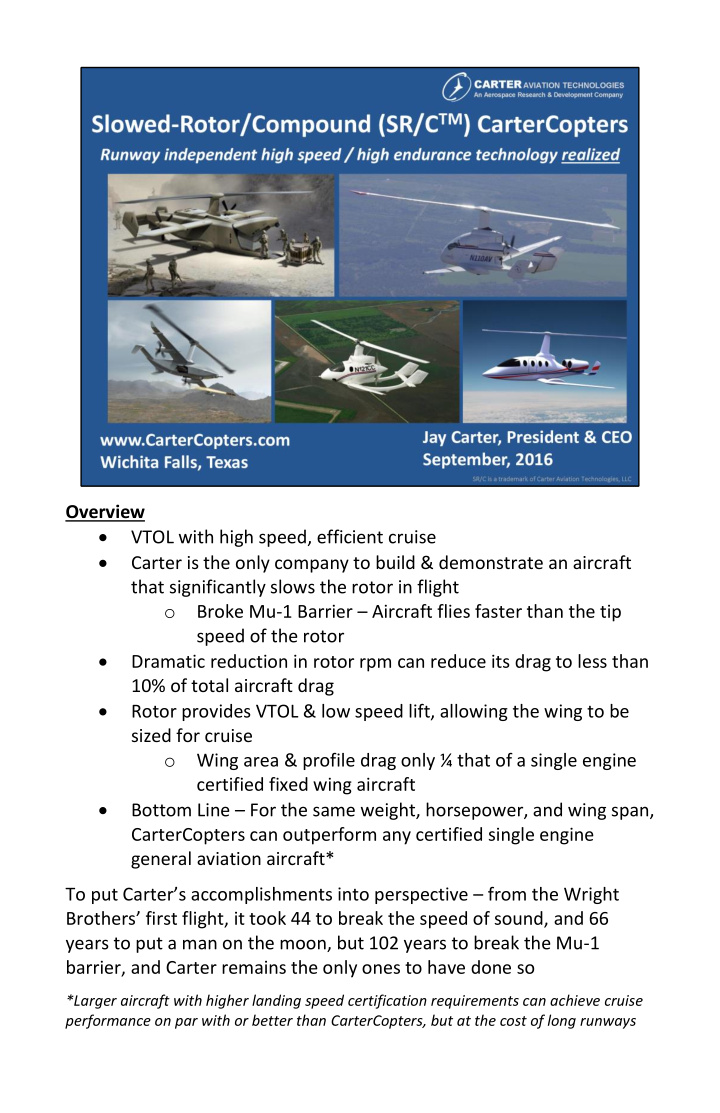



Overview VTOL with high speed, efficient cruise Carter is the only company to build & demonstrate an aircraft that significantly slows the rotor in flight o Broke Mu-1 Barrier – Aircraft flies faster than the tip speed of the rotor Dramatic reduction in rotor rpm can reduce its drag to less than 10% of total aircraft drag Rotor provides VTOL & low speed lift, allowing the wing to be sized for cruise o Wing area & profile drag only ¼ that of a single engine certified fixed wing aircraft Bottom Line – For the same weight, horsepower, and wing span, CarterCopters can outperform any certified single engine general aviation aircraft* To put Carter’s accomplishments into perspective – from the Wright Brothers’ first flight, it took 44 to break the speed of sound, and 66 years to put a man on the moon, but 102 years to break the Mu-1 barrier, and Carter remains the only ones to have done so *Larger aircraft with higher landing speed certification requirements can achieve cruise performance on par with or better than CarterCopters, but at the cost of long runways
Multi-Role CarterCopter o Light cargo, Strike, Medavac, Reconnsissance, Insertion of 4 troops Reconnaissance / Light Strike CarterCopter o Internal weapons bay for strike missions ISR CarterCopter Maritime CarterCopter o Persistent ISR o Wings fold to fit in destroyer hangar Light Cargo CarterCopter o Carries 1 Joint Modular Intermodal Container (JMIC) o Entire aircraft breaks down to fit in standard 20’ intermodal shipping container Heavy Cargo CarterCopter o Carries up to 4 JMICs o Much safer, less expensive method to supply troops
11 key technical challenges to slowing the rotor & maintaining stability First demonstrated feasibility with 6’ diameter test rotor o Mounted on front of pickup truck going down highway o 80 mph ‘aircraft’ speed with 10 mph tip speed o Maintained stability through turbulence of passing semi-trucks CCTD o 1st aircraft to break Mu-1 Barrier o L/D of 7 – 1.5 times better than best helicopter PAV o 2nd aircraft to break Mu-1 Barrier o L/D of 11 – 2.5 to 3 times better than best helicopters BizJet Concept o 500 mph, 2000 mile range o For about $30m, we could build this aircraft and break all the rotorcraft world records for speed, distance, altitude and climb to altitude (first 3 of those records have stood for 45+ years)
Carter licensed SR/C Technology to AAI for military applications AAI hired Bell Helicopters to validate the technology o Spent about $1m o Bell gave a very positive report on the technology AAI is owned by Textron who also owns Bell Helicopter and the tilt rotor Textron corporate would not provide political and financial support for SR/C o Without this support, AAI couldn’t move forward Carter negotiated exclusive rights to buy back the license for $6M
Additional Contact Info: Jay Carter, Jr., President & CEO Carter Aviation Technologies 2730 Commerce St., Ste 500 Wichita Falls, TX 76301 Office Phone: 940-691-0819 Mobile Phone: 940-704-2577 Fax: 940-691-5977
CHT-150 uses 2 F135 engines, with shaft power to the rotor, and jet exhaust rotated 60° to counter torque in hover CH-45 uses propellers for CHT-100 uses a single counter torque in hover F135 engine Further Explanations Extremely low rotor noise in cruise because of the low rotor rpm Fixed wing smoothness because the rotor is mounted on a tall soft mast to totally isolate rotor vibrations from the fuselage Unparalleled safety with built in- in rotor ‘parachute’ , but better than a parachute because the rotor with its high inertia tip weight needed for rotor stability at high speeds with the rotor slowed, can perform a zero roll, soft landing, from any altitude or speed. Something not even conventional helicopters can do. Cruise efficiency with rotor only 10% of total drag , because by slowing the rotor down to 1/3 hover rpm, this reduces the rotational HP/drag by a factor of 27 times. Small, simple, high aspect ratio wing for great efficiency . Wing can be ~1/4 the area of a certified single engine fixed wing aircraft, because with the rotor providing the lift for VTOL and low speed flight, the wing can be sized for cruise and not landing and taking off. No retreating blade stall . With the rotor producing almost no lift and with the rotor plan of rotation nearly parallel to the airstream, the blade airfoil angle of attack is so small it is impossible to stall. Landing gear safety . The landing gear has a smart all mechanical valve that determines the impact velocity in the first inch of deflection and then applies the appropriate constant pressure over the entire landing gear stroke to provide a near constant de-acceleration. With a stroke more than 24”, the landing gear can absorb landing impacts greater than 24 ft/sec – about the limit of jets landing on a carrier and about 5 times the limit on certified fixed wing aircraft.
For a given airspeed, reducing the rotor rpm by a factor of 3 (going from a hover rpm to a cruise rpm), reduces the rotor rotational drag by a factor of 27 o This is the key reason the SR/C can fly so efficiently The formula shown was developed all the way back in the 50’s to help illustrate / calculate the benefits of slowing the rotor down in flight. o Both the US and British government spent years and millions of dollars trying to slow the rotor down to achieve Mu-1 o They were not successful and gave up saying it was impossible or impractical. They gave up too soon!
Recommend
More recommend